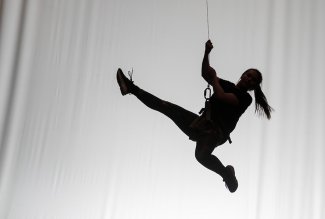
For one weekend last month, Ohio Northern University theatre students had the opportunity to take flight over the Freed Center for the Performing Arts stage under the expert guidance of ZFX Flying Effects Inc., a leader in performer flying.
The performer-flying workshop immersed students in the complicated world of aerial stage effects. The ZFX team of flying directors arrived on campus with a truck full of equipment and their expertise. ONU students learned how to install the block-and-tackle systems that control an actor in flight. They ran the cables and hoisted the rail systems into position in the grid deck suspended high above the stage. They checked, double-checked and triple-checked the flying systems for safety, and in the span of a few hours turned the Freed Center stage into something completely new and exciting, a launching pad ready for liftoff.
One of the main opportunities we like to present students with is the opportunity to see the way that performer flying is actually utilized within our industry,” says Wesley Miller of ZFX. “It gives them the chance to get their hands on the equipment as well as to start to learn some of the choreographing possibilities and what it takes to get the equipment in here.”
Performer flying is a far more complicated endeavor than an actual performance may suggest. An actor gracefully gliding through the air belies the technical acumen and sophisticated engineering in play behind the scenes to produce specific flying effects.
“They use a system of pulleys, ropes, wires and harnesses to make performers fly across the stage,” says Sylvia Fill, a freshman mechanical engineering student. “The pulleys let us use physics to our advantage. There are different types of systems, such as a one-to-one system, in which the puller who is operating the rope carries 100 percent of the body weight of the performer. A two-to-one system has counterweights, and there are other systems that help us not strain ourselves so much when we are operating a flying rig.”
Harnesses differ by the number and placement of pickup points. For example, a harness that allows actors to perform somersaults has two pickup points located at the hips with a wire connected to each. A so-called Tarzan harness has a single pickup point at the navel, while a rear pickup harness has a pickup point on the actor's upper back. Each harness has its purpose, and understanding the differences can be key to a successful production.
Most flying effects in musicals or plays use a dual rigging system to control an actor in flight. One operator (or team of operators) is responsible for lift, and another operator controls the movement across the stage. The lifting system includes thick ropes intended to fit comfortably in the hand. The fact that each one is rated for 26,000 pounds is just an added bonus. A pulley system is mounted to the stage floor and reduces the force required to lift an actor, but slows down the rate of ascent. For quick bursts into the air, an operator might actually jump off a ladder with the rope in hand and let gravity do the rest. Another operator uses a separate rope-and-pulley system to drag the actor back and forth across the stage. This operator must know the choreography perfectly, because ultimately he or she is responsible for making sure that the actor’s gestures match the movement. In this case, a single performance seen by the audience is actually a shared performance of three or more people; all but one is offstage.
Theatre is more of spectacle now,” says Brian Phillips, technical director of the Freed Center. “There are a ton of shows that are incorporating flying effects, but for most people the only way to learn how to do it is to actually work on one of those productions. We wanted to give our students experience with this, because it’s a big part of the industry now.”
Perhaps the most famous flying character in all of theatre is Peter Pan, but he is far from the only one. Broadway blockbusters Beauty and Beast, Wicked, and Mary Poppins all have flying characters, and as these shows grant stock-and-amateur licensing rights to colleges, high schools and community theatres, there is more need for flying effects.
As a learning experience, the workshop provided students with a bit of everything. Not only did they learn what it takes to prepare a theatre for flying effects, but they also learned how to rig everything up and how to do it safely. They learned how adding flying effects can alter a production in unanticipated ways — everything from lighting to props to costumes. They learned about the various movements that different harnesses and rigging can accommodate, and what it’s like to choreograph in three dimensions. They held the ropes in their hands, propelled their friends high into the air and discovered muscles they didn’t know they had.